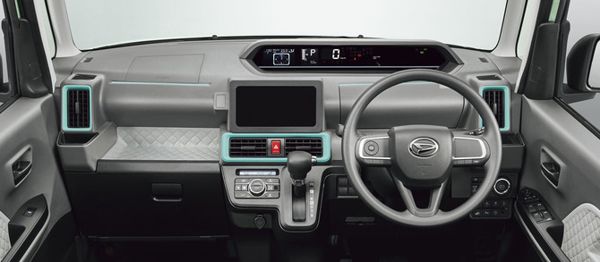Published
on 11
Oct 2021
|
All rights reserved.
|
|
|

|
|
DNGA
architecture gives Tanto a new lease of life.
|
|
Super-tall K-cars have
become the mainstream of Japanese mini car market for some years.
Daihatsu pioneered the idea in 2003 with the first generation Tanto.
Somehow, it was Honda N-Box that made this kind popular. Although the
last generation Tanto chased closely, it failed to overtake the Honda
in sales chart. It had many innovative features, such as twin-sliding
rear doors, B-pillarless structure and a sliding front passenger seat
that allowed the driver to get on board at the kerb side, but the
mechanical package was quite outdated, which hampered its driving
dynamics.
The new generation Tanto tries harder than ever to break the domination
of Honda. It has adopted an all-new chassis, new engine and new
transmission as well as added the latest adaptive cruise control,
collision prevention system and semi-automatic parking features. It is
built on the new modular platform called DNGA (Daihatsu New Global
Architecture, similar in concept but unrelated to Toyota’s TNGA), which
will form the basis for all the K-cars, A and B-segment small cars
produced
by Daihatsu, including those designed for developing countries and
those to be rebadged as Toyota. With a projected annual volume of 2.5
million units and a parts sharing rate of 75-80 percent, production
costs and development time will be slashed considerably.

|
|
Interior
design lacks imagination.
|
|
The new chassis utilizes high-strength steel to cut 40kg while lifting
rigidity by 30 percent. Center of gravity is lowered by 15mm, which
helps handling. The long-serving 3-cylinder engines have finally been
replaced with all-new units, which keep bore, stroke and bore spacing
dimensions but everything else is claimed to be new. It features
multi-spark ignition which cleans up emission. Sadly, power and torque
figures of the normally aspirated engine remain unchanged, which is
still
lower than its Honda and Suzuki counterparts. Turbo is better, as
larger turbo and intercooler lift peak torque from 68 to 74 lbft.
The turbo motor is also given a new dual-mode CVT, which combines a
conventional belt-type CVT (for low speed use) and a planetary gearset
(for higher speeds), increasing its ratio spread from 5.3 to 7.3 to
enhance fuel economy.
On the road, the driving dynamics is much improved. Faster (in case of
turbo), more linear acceleration (in case of D-CVT), higher refinement
at cruising, less body roll, heavier steering, sharper braking
response… the result is night and day difference from the old car.
Having said that, it is still an extremely tall K-car, not something
you can push hard in corner. It lacks power to do so, too.

|
|
Automatic
sliding door, lack of B-pillar and sliding seats, no other cabins could
be as easy to access.
|
|
However, the greatest assets remain to be cabin space and features. The
super-high roof allows children to stand straight in the cabin. The
dual-sliding doors and B-pillarless structure at the kerb side allow
easy entry and exit, especially as the floor is now 16mm lower. The
power sliding door can now sense your smartkey and slide open when you
approach, then close automatically when you leave, very convenient if
you are carrying children or bulky luggage. The driver seat and front
passenger seat can slide longitudinally for 540mm and 380mm,
respectively, so getting from the roadside straight to the driver seat
becomes even easier. The rear seat is an improvement, too. Now it can
split and slide for 240mm to alter luggage space, and it takes one
instead of two actions to drop onto the floor and fold flat. As before,
by detaching the front seat headrests and reclining all seats, the
cabin
can be converted into a double bed. All these features make the Tanto
extremely practical for families with small children.
Plastics in K-car cabins are usually cheap. The Tanto is no exception.
Its dashboard architecture places function above style, low cost
against character. While the air vent bezels look like customizable,
they are actually part of the dashboard molding. While the high-mounted
digital instrument keeps your vision close to the road ahead, it leaves
a large piece of shinny plastic at where used to be placing instrument
pod. Some more imagination won't go amiss.
|
Verdict:    |
|